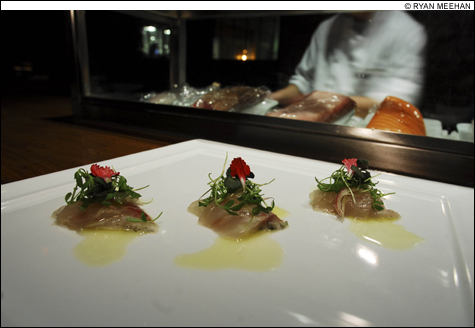 |
O Ya chef Tim Cushman is not a monkey. Let me clarify: it used to be that a trained monkey could make great sashimi. A very well-trained monkey, but a monkey nonetheless. Teach it a couple of knife skills, provide it with some super-rich, screamingly fresh hamachi, and you’d have the best sashimi you could possibly hope for. It’s a hard job, sure, but it’s a technical job, not a creative one. These days, sashimi has moved beyond the sphere of the get-the-best-then-don’t-mess-with-it approach. Western-style vinaigrettes, exotic fruits and vegetables, and flavored foams are de rigueur at any high-end sashimi joint. But all too often, these places fall into a trap: creativity trumps technique, and the dishes suffer. When I go out, I want someone who learned sashimi the hard way; someone who has the subtle nuances of texture and flavor of each fish in his bones; someone who knows exactly what will bring out the best flavors in the seafood without overwhelming it. Someone who put in the time before he started messing with things.
With a résumé that includes an apprenticeship at Nobu — the granddaddy of new-style sashimi — along with 25 years of traveling, cooking, and biding his time before opening his first solo venture, Tim Cushman is one of the few in Boston who fit this bill. A single crispy boned chicken wing brined in yuzu juice and stuffed with shiitake and cabbage ($12) is revelatory in its complex interplay of sweet and savory flavors, while a sashimi of diver scallop and foie gras with vin cotto and shiso-marinated grapes ($25) manages to combine Japanese, French, Italian, and American elements into a single extravagant dish, while still maintaining the individuality of each ingredient.
But Cushman’s greatest asset is his restraint. He knows exactly when to sit back and let the ingredients do the talking, albeit with slight prods. Case in point: the kinmedai sashimi. Similar to sea bream in size and appearance, it has an ultra-smooth texture and mild flavor that a less refined, overzealous chef could easily destroy. Standard dark soy sauce and pickled ginger can overwhelm a fish like this. Instead, Cushman serves it with a milder white soy sauce and paper-thin slices of myoga, the subtly perfumed un-opened buds of a Japanese flower. Instead of the sharp citrus tang of sudachi or yuzu, the fish is drizzled with lemon oil. The floral oil not only adds its own subtle perfume, but also acts as a vehicle to pick up the other flavors in the dish and deliver them in one mouth-coating bite. It’s restraint at its opulently satisfying best.
Available for $19 at O Ya, 9 East Street, in Boston. Call 617.654.9900.